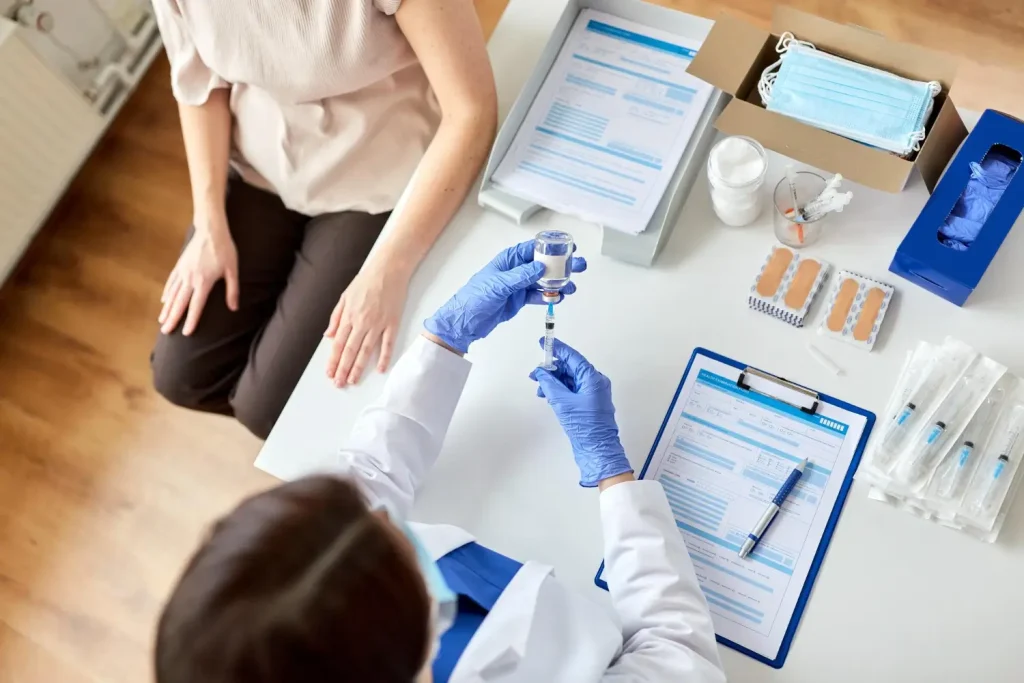Nicotinamide adenine dinucleotide (NAD) injections vs. IV are two delivery methods for a vital coenzyme needed for cellular energy production and DNA repair.1
In dermatology and aesthetic medicine, NAD has gained attention for its potential to improve skin quality and support anti-aging protocols. Its regenerative properties make it a valuable addition to treatments aimed at skin rejuvenation, particularly post-procedure healing.
Clinically, NAD can be delivered either through injections or via intravenous infusion. In this article, we’ll compare NAD injections vs. IV therapy in detail to help you guide your patients toward the most suitable option.
Key Takeaways
- NAD injections can be delivered intramuscularly or subcutaneously for slower, more gradual absorption compared to IV therapy.
- IM injections target muscles like the deltoid or vastus lateralis. The amount of NAD reaching the circulation peaks in 30–60 minutes with effects lasting 6–8 hours.
- Subcutaneous injections have the slowest absorption. Through this route, the plasma concentration peaks in 1–2 hours, and NAD maintains steady levels for 8–12 hours.
- IV NAD therapy provides 100% bioavailability, with an immediate plasma peak.
- The dosage for IM NAD injection ranges from 25–100 mg 1–2 times weekly. Subcutaneous dosage starts at ~20 mg, titrating to 100 mg. IV sessions use 500–1,000 mg over 2–4 hours.
- IV therapy is more resource-intensive since it requires venous access, infusion equipment, and monitoring for 1–6 hours.
- Side effects of injections are local, such as pain, tenderness, bruising, and mild flushing. NAD injections have systemic side effects like nausea, flushing, hypotension, tachycardia, and muscle tightness, which are rate-dependent.
What Are NAD Injections?
NAD injections deliver nicotinamide adenine dinucleotide either into muscle tissue via intramuscular (IM) administration or under the skin via the subcutaneous (SubQ) route. A 25–27 gauge syringe is used to deliver the co-enzyme.
IM NAD is injected into the deltoid, vastus lateralis, or dorsogluteal muscles. The injection creates a depot within muscle tissue, allowing for gradual absorption into systemic circulation.
SubQ administration into the abdominal wall or upper thigh offers an even slower absorption rate. The compound diffuses through the subdermal adipose layer before reaching circulation.
The pharmacokinetic profile of NAD injections is favorable for patients who experience adverse reactions to the abrupt rise in levels during IV therapy. Examples include chest tightness, flushing, or nausea.
Gradual absorption also allows for stable intracellular NAD replenishment. It supports mitochondrial oxidative phosphorylation, sirtuin activation, and DNA repair mechanisms over an extended period.
From a procedural standpoint, NAD injections are less resource-intensive than IV administration. They require no venous cannulation or infusion pump. This means they can easily be integrated into a busy outpatient aesthetic or dermatology practice.
What Is NAD IV Therapy?
NAD IV therapy delivers nicotinamide adenine dinucleotide into the venous circulation via continuous intravenous infusion. The IV route bypasses all absorption barriers and results in immediate systemic availability. It also allows for precise control over infusion rate and dosage.
Unlike intramuscular injections, IV administration achieves a rapid and high plasma concentration of NAD that quickly saturates intracellular stores. It is the preferred delivery method for high-dose protocols, acute replenishment, or patients with significant mitochondrial dysfunction who require an aggressive restoration of NAD levels.
However, the speed of delivery must be carefully titrated, as rapid infusions can trigger vasodilatory reactions such as flushing, lightheadedness, or chest pressure.
NAD IV therapy requires venous access via a peripheral vein in the forearm or antecubital fossa, and dedicated monitoring over a 1–3 hour session.2
Differences Between NAD Injections vs. IV Therapy
Here are the differences between NAD injection vs. infusion.
Dosage
There is no FDA-approved NAD drug product or labeled dosing, so the dosage regimens for both delivery systems are based on clinical experience and patient tolerance.3
IM dosing starts at 25–50 mg and escalates to 100 mg based on patient response, once or twice weekly. Some intensive protocols administer 250–500 mg daily for four days before reducing to maintenance frequency.
The starting regimen for SubQ injections is a 200 mg/mL preparation, beginning at 0.1 mL (≈20 mg) three times per week and increasing by 0.1 mL weekly to a maximum of 0.5 mL (≈100 mg) three times weekly.
For IV administration, most clinics use 500–1,000 mg per session, with some protocols extending to 1,500 mg in high-demand cases. Infusions are delivered over 2–4 hours to avoid adverse reactions. The loading phase consists of daily infusions for 3–10 consecutive days, followed by maintenance sessions spaced weekly or biweekly.4
Absorption and Bioavailability
SubQ injections have the slowest absorption profile. NAD diffuses from the subdermal adipose tissue into capillaries and lymphatics, creating a prolonged release curve. Peak plasma levels are reached in 1–2 hours.
IM injections get absorbed through local capillary networks, so their bioavailability is lower than IV injections.
IV administration delivers NAD into the venous circulation with 100% bioavailability by bypassing all absorption barriers. Plasma concentrations peak almost immediately upon infusion.5
Treatment Duration
For NAD injections, both IM and SubQ, the administration time is minimal. An IM injection can be completed in under two minutes from needle insertion to withdrawal. SubQ injections take roughly the same time, though more care is required with smaller-gauge needles to avoid discomfort in adipose tissue.
The “treatment duration” for injections refers not to the administration time but to how long therapeutic plasma and intracellular NAD levels remain elevated. With IM injections, plasma levels typically peak within 30–60 minutes and then decline gradually over 6–8 hours.
SubQ administration extends the absorption phase, with plasma levels peaking at 1–2 hours and maintaining a steadier curve for 8–12 hours.
In contrast, NAD IV therapy requires a significantly longer patient commitment. Infusions delivering 500–1,000 mg take 2–4 hours, and slower drip rates are necessary to mitigate side effects.
Some clinics use high-dose protocols extending to six hours for patients receiving 1,500 mg or more.
Patient Experience and Preferences
The choice between NAD injection vs. IV also depends on the patient’s preference.
An IM or SubQ dose appeals to patients with limited time or those who dislike being tethered to an infusion setup.
The minimal time commitment also makes injections an attractive choice for patients on maintenance regimens or those integrating NAD therapy into an already busy procedural schedule.
IV therapy, while more time-intensive, offers the reassurance of constant supervision. It also allows for the delivery of higher doses in a single sitting.

Safety Considerations for NAD Injections vs. IV
NAD injections are well-tolerated by most patients. IM or subQ delivery reduces the likelihood of acute systemic reactions, but it may lead to localized discomfort. Possible side effects of an IM or SubQ injection include:
- Pain, tenderness, or swelling at the injection site
- Local hematoma or bruising
- Localized infection
- Delayed-onset muscle soreness
- Mild flushing or transient warmth sensation
- Vasovagal reaction during administration
With IV infusion, the rapid elevation of NAD levels can trigger more pronounced systemic reactions. These are infusion-rate dependent and may require slowing the drip or temporarily pausing administration.
Possible side effects of IV administration include:6
- Nausea or stomach cramping
- Headache
- Lightheadedness
- Flushing or increased skin warmth
- Hypotension and tachycardia
- Muscle tightness, particularly in the chest or neck
- Hypersensitivity reaction
- Phlebitis at the IV site
- Transient weakness post-infusion
Final Words
Medical Spa Rx can help you gain access to products like REJUVANAD+ at wholesale prices.
Contact us today to learn more about buying REJUVANAD+ for your practice.
FAQs
Can NAD Injections and IV Therapy Be Combined in One Treatment Plan?
Yes. NAD injections and IV therapy can be combined. Many patients start with IV for rapid loading and then switch to injections for maintenance.
What Is in NAD IV Therapy?
NAD IV therapy contains nicotinamide adenine dinucleotide combined with electrolytes, saline, and sometimes vitamins or amino acids to support cellular repair.
Now Often Should You Get NAD IV?
Begin NAD IV therapy with 1–2 sessions per week for 4–6 weeks to achieve a strong therapeutic effect. After this loading phase, continue with maintenance infusions every 4–6 weeks to sustain results.
Do NAD Injections Hurt More Than IV Therapy?
NAD injections can cause more localized discomfort than IV therapy due to the smaller injection site and faster fluid deposition into muscle or subcutaneous tissue.
Who Should Avoid NAD Injections and IV Drips?
Individuals with severe liver or kidney disease, uncontrolled heart conditions, active cancer, or known hypersensitivity to NAD should avoid both injections and IV drips. Pregnant or breastfeeding women, and those with unexplained chronic illnesses, should only consider NAD therapy under strict medical supervision.
References
1. Amjad S. Role of NAD+ in regulating cellular and metabolic signaling pathways. Molecular Metabolism. 2021;49:101195. doi:https://doi.org/10.1016/j.molmet.2021.101195
2. Beecham GB, Tackling G. Peripheral line placement. PubMed. Published 2023. https://www.ncbi.nlm.nih.gov/books/NBK539795/
3. Center. FDA reminds compounders to use ingredients suitable for sterile compou. U.S. Food and Drug Administration. Published 2024. https://www.fda.gov/drugs/human-drug-compounding/fda-reminds-compounders-use-ingredients-suitable-sterile-compounding
4. Tailor S. NAD+ Dosing Review: Routes, Protocols & Case Study Insights. Fagronacademy.us. Published 2025. Accessed August 16, 2025. https://www.fagronacademy.us/blog/nicotinamide-adenine-dinucleotide-nad-a-review-on-dosing
5. Price G, Patel D. Drug Bioavailability. PubMed. Published July 30, 2023. https://www.ncbi.nlm.nih.gov/books/NBK557852/
6. de I, Ferrari G, Luiz, et al. Evaluation of safety and effectiveness of NAD in different clinical conditions: a systematic review. Endocrinology and metabolism/American journal of physiology: endocrinology and metabolism. 2024;326(4):E417-E427. doi:https://doi.org/10.1152/ajpendo.00242.2023


